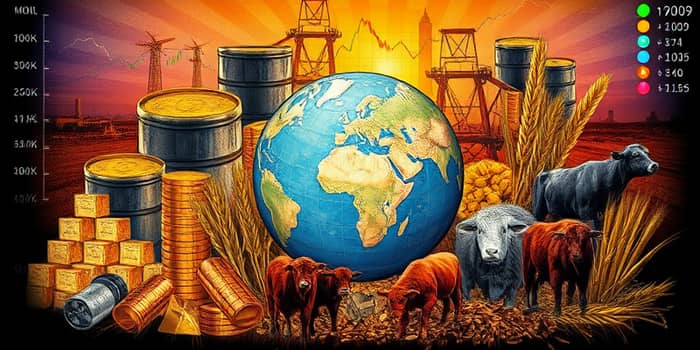Commodity investing has long been a cornerstone of global finance, offering investors access to the essential building blocks of modern economies. From energy and metals to agricultural crops and livestock, commodities influence everything from production costs to inflation. Understanding how these raw materials trade, why their prices fluctuate, and how to include them strategically in portfolios is critical for both seasoned investors and newcomers.
What Are Commodities and Why They Matter
Commodities are tangible assets that serve as the foundation for countless industries worldwide. They include energy products like oil and natural gas, metals such as gold and copper, agricultural goods like wheat and coffee, and livestock. These assets are often interchangeable, with few distinguishing features beyond quality grades, making them unique financial instruments.
By acting as inputs in manufacturing, construction, and food production, commodities play a vital role in shaping global trade flows. Shifts in commodity prices can ripple through supply chains, impacting consumer prices, industrial output, and government policies. Tracking these changes offers investors a lens into broader economic dynamics, including inflationary pressures and geopolitical tensions.
At its core, commodity investing provides a direct link to the real economy. Whether through futures contracts, physical holdings, or equity exposure in producing companies, investors gain exposure to the underlying demand and supply fundamentals that drive market behavior.
Trends Shaping Commodity Markets in 2025
The commodity landscape in 2024–2025 has been defined by significant volatility and shifting trends. After a sharp 14% decline in 2023, broad commodity prices enjoyed a modest rebound in 2024 before falling an estimated 12% in 2025. Forecasts suggest another 5% drop in 2026, driving prices toward six-year lows.
- Highest price volatility in at least 50 years has been observed, with frequent and abrupt swings.
- Gold hit a record high of $2,790 per ounce in 2024, while silver reached $35 per ounce.
- Brent crude oil is expected to average $73 per barrel in 2025, closing the year below $70.
- Agricultural commodities saw extreme moves: coffee soared 70.8% and sugar climbed 29.9% in 2024.
Natural gas prices surged by 33.8% in 2024, driven by supply constraints and weather events, whereas US and European crude oil fell approximately 5%, heating oil declined 14.1%, and diesel dropped 7.5%.
Key Drivers of Price Movements
Commodity prices are influenced by a complex web of factors that interact on global and local scales. Recognizing these drivers is crucial for investors seeking to anticipate market shifts and manage risk effectively.
- Economic growth trajectories: Slowing global growth often reduces industrial demand, pressuring prices.
- Geopolitical tensions and trade policies can disrupt supply chains and create premium pricing.
- Extreme weather events, such as El Niño, can cripple agricultural output and spark rapid price spikes.
- Currency fluctuations, especially in the US dollar, alter the affordability of dollar-denominated commodities worldwide.
Approaches to Commodity Investment
Investors can access commodities through various vehicles, each with its own advantages and drawbacks. Selecting the right approach depends on risk tolerance, investment horizon, and logistical considerations.
Physical commodities—holding bullion or barrels—offer direct exposure but involve significant storage and transportation challenges. As a result, most investors prefer financial instruments:
- Futures and derivatives: Contracts allow speculation and hedging but carry margin requirements and rollover costs.
- Commodity funds and ETFs: Provide diversified exposure without the need for physical storage.
- Equity investments in producers: Shares of mining companies, oil majors, and agricultural firms can yield dividends and some inflation protection.
While long-only strategies often struggle to outperform benchmarks, factor-based and dynamic tactical strategies can capture additional risk premia by exploiting momentum, value, and basis anomalies.
Diversification and Strategic Benefits
Incorporating commodities into a broader portfolio may offer substantial benefits. Historically, commodities exhibit low correlation with stocks and bonds, helping to cushion portfolios during market drawdowns and inflationary spikes.
As an inflation hedge, commodities stand out among asset classes. Rising consumer prices often coincide with higher commodity costs, providing a natural counterbalance. However, the effectiveness varies by commodity and market conditions.
Strategic, long-term allocations can reduce overall portfolio volatility, while tactical rebalancing—shifting exposure based on market signals—may capture additional gains. Investors should strike a balance between passive exposure and active management to optimize risk-adjusted returns.
Risks Investors Should Consider
Despite their benefits, commodities carry unique risks that require careful assessment:
- Extreme volatility: Price swings can exceed those of equities, leading to sudden losses.
- Concentration risk: Many commodity funds focus heavily on a few sectors, magnifying sector-specific downturns.
- Derivatives complexity: Futures and options introduce leverage, which can amplify both gains and losses.
- Political and regulatory shifts: Trade restrictions, environmental regulations, and OPEC decisions can rapidly alter supply dynamics.
The Role of Experts and Policy Shifts
In an environment marked by rapid change, experienced traders and asset managers play a pivotal role. Advanced analytics, risk models, and real-time data help navigate market inefficiencies and mitigate downside risks.
Regulatory and policy developments in 2025 are poised to reshape trading rules, environmental standards, and international cooperation. ESG considerations, carbon pricing, and sustainability mandates are increasingly influencing investment flows and supply chain decisions.
Major Commodity Types at a Glance
Benchmarks, Indices, and Future Outlook
Key benchmarks such as the S&P GSCI and Bloomberg Commodity Index serve as reference points for measuring performance. Weighting schemes, rebalancing rules, and the inclusion of volatile components like natural gas significantly impact index returns.
Looking ahead, most analysts anticipate downward pressure on commodity prices through 2025 and into 2026, barring unexpected supply shocks. Factor innovation and dynamic strategies are expected to gain traction as investors seek more resilient returns. The growing focus on ESG and sustainability is also likely to drive structural shifts, influencing both production practices and capital allocation.
Ultimately, commodity investing demands a deep understanding of market fundamentals, disciplined risk management, and the flexibility to adapt to evolving conditions. By combining strategic allocations with tactical insights, investors can harness the unique characteristics of raw materials markets to enhance portfolio resilience and capture opportunities in a complex global economy.
References
- https://brainworksinc.com/commodities-market-experienced-traders-2025/
- https://climateinstitute.edhec.edu/factor-based-commodity-investing
- https://www.aberdeeninvestments.com/en-us/institutional/insights-and-research/commodities-the-year-that-was-the-year-that-could-be-2025-inst
- https://www.fidelity.com/learning-center/investment-products/mutual-funds/about-commodity-investing
- https://www.nerdwallet.com/article/investing/commodity-stocks
- https://www.pimco.com/us/en/resources/education/understanding-commodities










